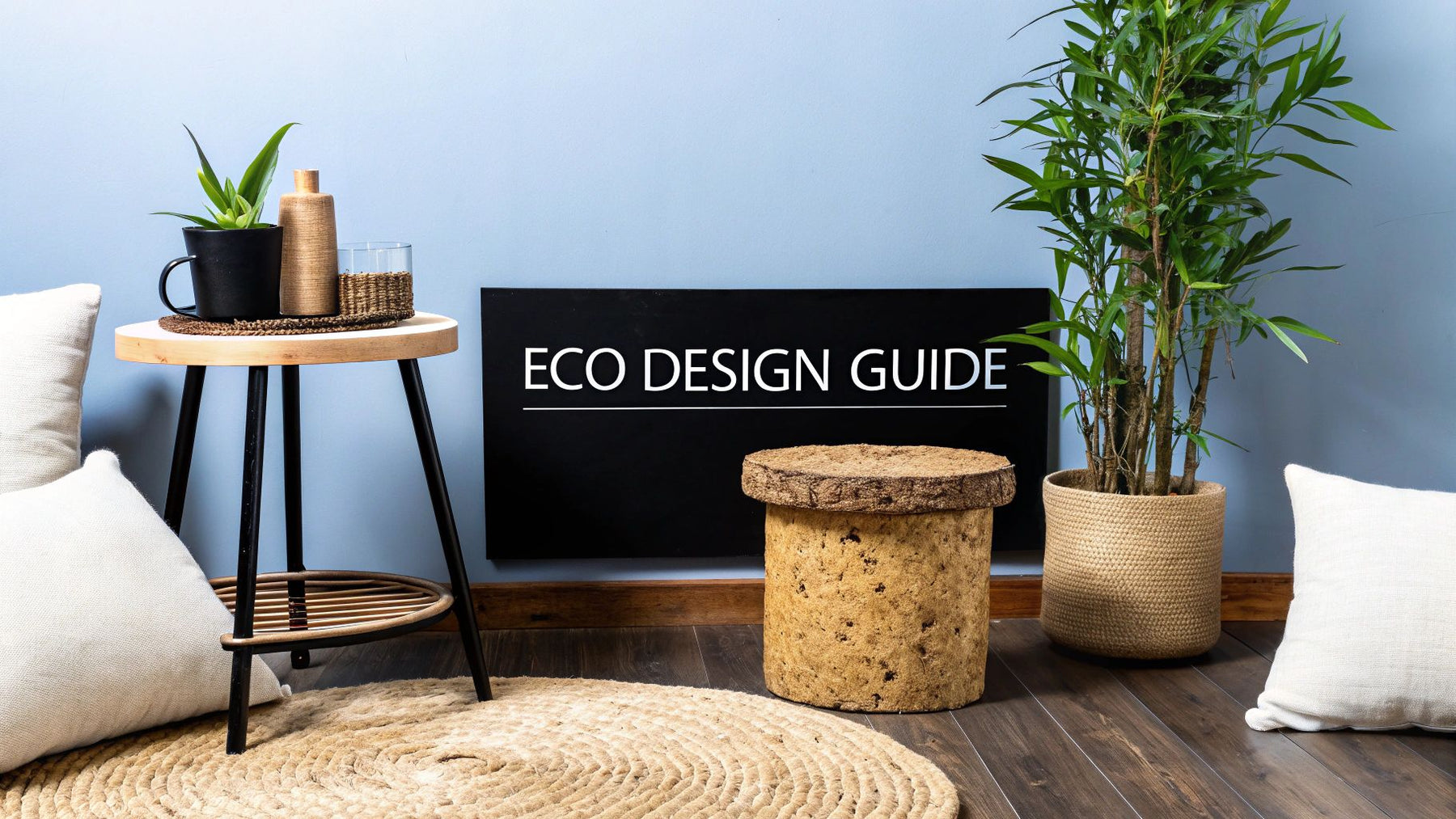
Sustainable Interior Design Materials: An Expert Guide
Let's be real—the term "sustainable" gets thrown around a lot. So, what does it actually mean when we're talking about home decor?
Simply put, sustainable interior design materials are resources chosen for their minimal negative impact on the planet and their positive effect on people. This goes way beyond just using recycled stuff. It’s about looking at the entire life story of a material—from where it grew to how it got to your living room.
This guide will walk you through everything you need to know, from the core principles of sustainability to the best materials and how to spot authentic eco-friendly products.
Table of Contents
- What Makes a Material Truly Sustainable?
- The Global Shift Towards Healthier Homes
- Exploring Key Sustainable Material Categories
- How to Read Eco-Labels and Certifications
- Bringing Sustainable Materials Into Your Home
- Frequently Asked Questions About Sustainable Design
What Makes a Material Truly Sustainable?
What qualifies a material as sustainable isn't a single quality. It’s a bigger-picture approach that stands on three core pillars: environmental responsibility, social fairness, and long-term value. Thinking about these helps you see past the simple "eco-friendly" sticker.
Imagine choosing between two coffee tables. One is a cheap, mass-produced particleboard unit, held together with glues packed with chemicals. The other is a handcrafted table made from reclaimed barn wood.
The particleboard table might seem like a bargain, but it required tons of energy to produce and can release fumes into your home. Its lifespan is short, and it's almost guaranteed to end up in a landfill.
The reclaimed wood table, however, tells a different story. It gives old materials a second life, preventing waste and avoiding the need to cut down new trees. It's built to last for generations, making it an investment in quality, your family's health, and the planet's future.
The Three Core Principles
To really get what makes a material sustainable, let's break down these foundational ideas.
-
Environmental Responsibility: This is all about the planet. It covers materials that are renewable (like bamboo), recycled (like countertops from glass bottles), or reclaimed. It also means choosing non-toxic materials with low Volatile Organic Compound (VOC) emissions, which is a huge win for your home's air quality.
-
Social Fairness: Sustainability isn't just about the environment; it's about people. This principle ensures materials are sourced and produced ethically. That means supporting fair wages and safe working conditions. Certifications like Fair Trade are great indicators.
-
Long-Term Value and Durability: A truly sustainable item is one you won't throw out in a few years. This pillar is about high-quality, durable materials that stand the test of time. It's choosing timeless design over fleeting trends, which naturally reduces waste.
To make this even clearer, here’s a quick look at these principles in action.
The Pillars of Sustainable Materials at a Glance
| Pillar | What It Means for Your Home | Example Material |
|---|---|---|
| Environmental Responsibility | Cleaner indoor air, less waste, and a smaller carbon footprint. | Cork flooring, harvested from tree bark without harming the tree. |
| Social Fairness | Supporting businesses that treat their workers with dignity and respect. | A handwoven rug with a Fair Trade certification. |
| Long-Term Value | Investing in pieces that last a lifetime, saving you money and reducing landfill waste. | A solid dining table made from reclaimed lumber. |
Ultimately, choosing sustainable materials is about making conscious decisions.
Choosing sustainable materials is an investment in your home's health, aesthetic, and the planet's future. It's about creating spaces that are not only beautiful but also responsible.
If you want to dive deeper, exploring a guide on different eco-friendly flooring options is a fantastic next step. This knowledge empowers you to make thoughtful choices for every surface in your home.
The Global Shift Towards Healthier Homes
Choosing sustainable materials isn't just a niche trend—it's a global movement. We're seeing a fundamental shift in how people approach their living spaces, driven by homeowners who are more conscious of their environmental footprint and personal well-being. It’s a move away from the disposable and toward the durable, healthy, and meaningful.
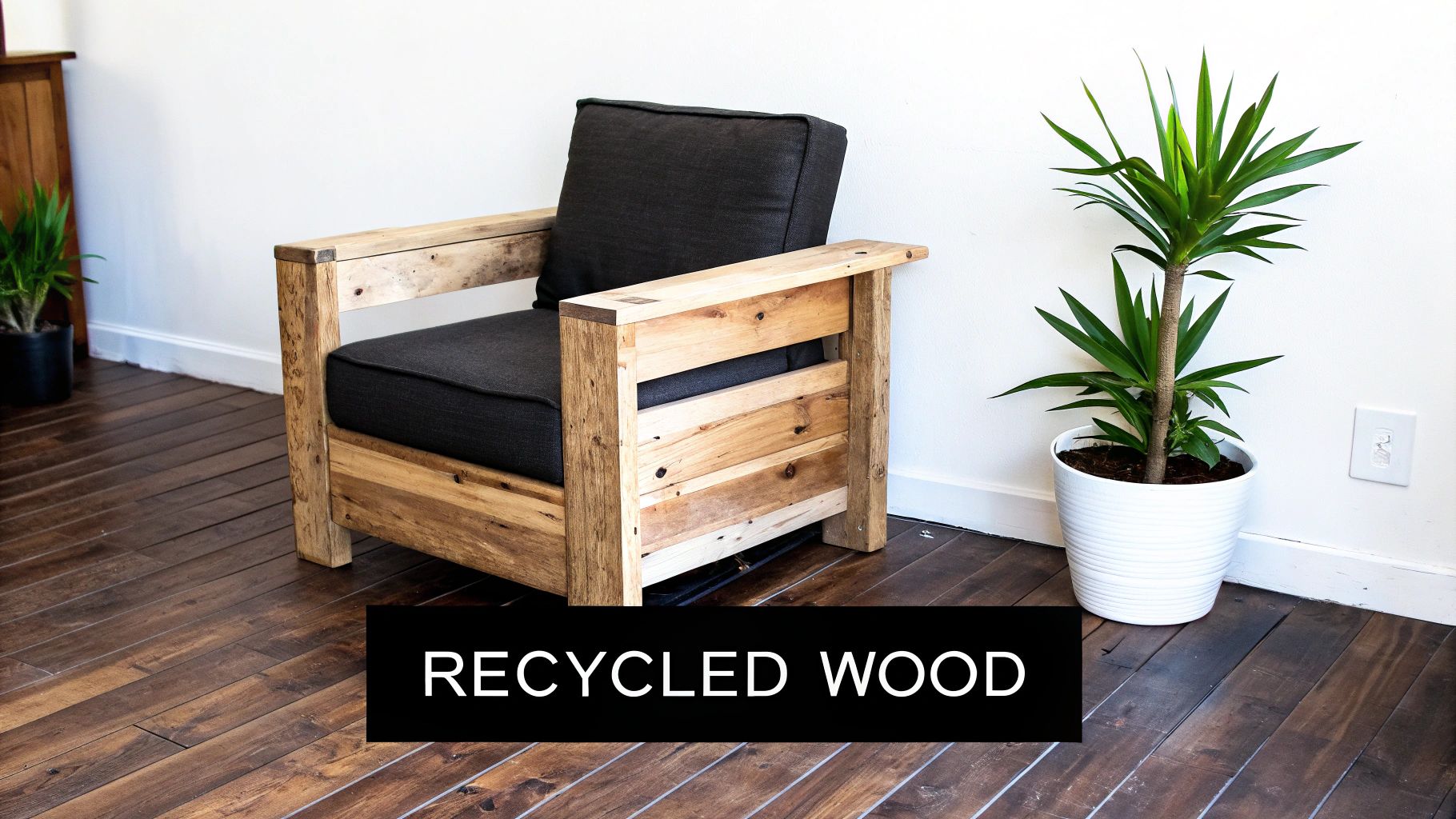
This isn’t just a feeling; the numbers back it up. The global market for sustainable home decor was valued at around USD 4.5 billion in 2024. Projections show it more than doubling to roughly USD 9.4 billion by 2034, growing at a steady clip of 7.9% each year.
This incredible growth isn't happening in a vacuum. It’s propelled by a few key factors that resonate with modern homeowners.
Why Are More People Choosing Sustainable Homes?
Three big drivers are fueling this demand for healthier, more conscious home environments. Each one reflects a deeper cultural change in our relationship with our homes and the planet.
-
Heightened Environmental Awareness: We're more informed than ever. Homeowners want to know where their products come from, how they were made, and what happens at the end of their life. This is pushing brands to adopt more responsible practices.
-
A Focus on Health and Wellness: There's a growing understanding of how indoor spaces affect our health. Concerns about poor air quality caused by Volatile Organic Compounds (VOCs) have made low-VOC and non-toxic materials a top priority.
-
The Rise of Mindful Consumption: We are shifting away from "fast fashion" decor and embracing a "buy less, but better" philosophy. This means investing in high-quality, timeless pieces, which reduces waste and creates more personal spaces. You can dive deeper into this approach in our article on environmentally friendly interior design.
"The modern home is becoming a sanctuary. People want spaces that not only look good but also feel good—and that feeling comes from knowing your choices are healthy for your family and kind to the planet."
Biophilic Design and Consumer-Led Innovation
A fascinating part of this movement is biophilic design—the idea of connecting people with nature by bringing natural elements indoors. Think indoor plants, tons of natural light, and organic materials. This approach has been proven to reduce stress and improve air quality.
As demand surges, it's sparking creativity from designers and manufacturers who are developing beautiful, high-performance materials. Even specific product categories are getting an eco-friendly makeover, like eco-friendly blinds and sustainable window options, which play a vital role in a healthier home.
The takeaway is clear: you are part of a major movement shaping the future of home design, one thoughtful choice at a time.
Exploring Key Sustainable Material Categories
Diving into the world of sustainable materials is where the real fun begins. This is your practical guide to some of the most beautiful, versatile, and impactful options out there. We'll explore the story behind each material, its benefits, and how it can transform a space.
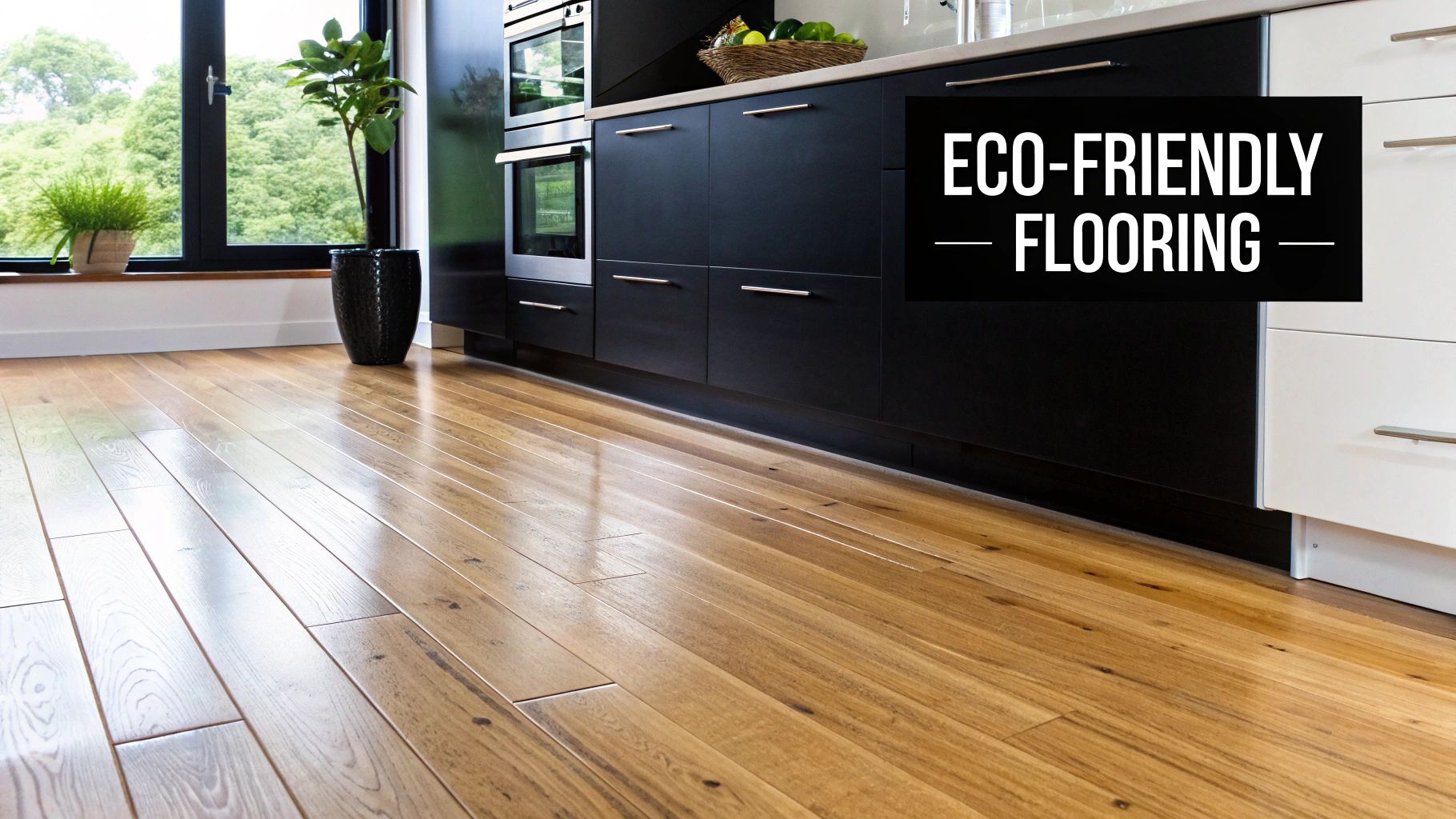
Reclaimed Wood: The Storyteller
Imagine wood with a past. That's reclaimed wood—salvaged from old buildings, barns, and even wine barrels. Each plank carries a history, complete with nail holes and a rich patina you can't fake. It’s the ultimate storyteller among sustainable interior design materials.
Giving this old wood a new life not only keeps it out of landfills but also reduces the demand for new timber, helping protect our forests. The energy needed to repurpose it is a fraction of what’s required for harvesting new lumber.
Common Uses:
- Feature Walls: Creates a warm, rustic focal point.
- Furniture: Dining tables, coffee tables, and headboards full of character.
- Flooring: Offers unparalleled charm and durability.
This isn't just a niche trend. By 2025, sustainable and reclaimed timber are expected to be major players in global markets. In fact, sales of FSC-certified wood products have grown over 12.5% CAGR from 2021 to 2024 globally. You can see more on trending interior design materials at Domkapa.
Bamboo: The Rapid Renewable
Here’s a fun fact: bamboo is technically a grass, and it's one of nature’s most impressive performers. Some species can shoot up three feet in a single day, making it an incredibly renewable resource. It matures in just three to five years, a stark contrast to traditional hardwoods.
Even better, bamboo requires no pesticides and regenerates from its own roots after being harvested. It's strong, versatile, and brings a clean, modern aesthetic to any space.
Bamboo is a sustainability superstar. Its rapid growth and self-regenerating nature make it one of the most efficient and eco-friendly building materials on the planet.
Common Uses:
- Flooring and Cabinetry: A durable alternative to traditional hardwood.
- Furniture: From minimalist chairs to sturdy shelving.
- Housewares: Beautiful cutting boards and utensils.
- Window Treatments: Woven bamboo shades offer natural texture and light filtering.
Cork: The Quiet Insulator
Harvested from the bark of the cork oak tree, cork is a truly remarkable material. The bark can be stripped every nine years without harming the tree, which can live for up to 200 years. These cork forests are also hotspots for biodiversity.
Cork’s natural honeycomb-like structure makes it a fantastic insulator against sound and temperature. It’s also antimicrobial, water-resistant, and has a wonderful cushion underfoot.
Key Benefits of Cork:
- Acoustic Insulation: It absorbs sound, making rooms quieter.
- Thermal Insulation: Helps keep your home warmer in winter and cooler in summer.
- Comfort and Durability: Its natural elasticity is easier on your joints.
Recycled Glass: The Colorful Comeback
Recycled glass gives post-consumer waste—like bottles and windows—a glamorous second act. The glass is crushed, melted, and reformed into stunning new products. This process uses far less energy than creating new glass from raw materials.
It’s a fantastic way to add a pop of color and unique texture to your home while keeping waste out of landfills. Because glass can be recycled almost endlessly, it’s a perfect example of a circular material.
Common Uses:
- Countertops: Crushed glass pieces create durable, eye-catching surfaces.
- Backsplashes and Tiles: Add a vibrant quality to kitchens and bathrooms.
- Decorative Accents: Vases, bowls, and other decor.
Natural Fabrics: The Healthy Textiles
The fabrics we choose for curtains, upholstery, and bedding have a huge impact on our home's health. Sustainable natural fabrics are grown without synthetic pesticides and are processed with minimal chemicals.
Top Natural Fabric Choices:
- Organic Cotton: Grown without harsh chemicals, it's softer and better for your skin.
- Linen: Made from the flax plant, which needs little water. It's naturally hypoallergenic and breathable.
- Hemp: A durable, fast-growing plant that enriches the soil it grows in.
- Jute: Known for its earthy texture, jute is a highly renewable fiber often used for rugs.
When picking fabrics, especially for children's rooms, natural fibers are a great choice. You can explore our guide on choosing the best window treatments for a nursery for more ideas on creating a safe space.
How to Read Eco-Labels and Certifications
Walking into the world of sustainable products can feel like trying to decipher a secret code. Many brands use vague terms like "eco-friendly," making it hard to tell who’s genuinely committed and who’s "greenwashing." The key? Third-party certifications.
Think of these official labels as a trusted translator. They are your proof that a product has met specific, rigorous standards for environmental or social impact. Learning to spot these logos is the best tool for making choices that align with your values.
The Most Common Labels to Know
While there are dozens of certifications, a few key players show up again and again. Getting to know these main ones will cover you for almost any purchase.
Here are the heavy hitters you’ll want to commit to memory:
- Forest Stewardship Council (FSC): This is the gold standard for anything made from wood. An FSC logo is your guarantee that the material was sourced from a forest managed to protect biodiversity and uphold indigenous peoples' rights.
- GREENGUARD: Your go-to for healthier indoor air. GREENGUARD Certification means a product has passed tough tests for low emissions of volatile organic compounds (VOCs).
- Fair Trade Certified: This label shifts the focus from the planet to its people. When you see the Fair Trade logo, you know the artisans earned a fair wage and worked in safe conditions.
This infographic breaks down how popular sustainable materials stack up against each other.
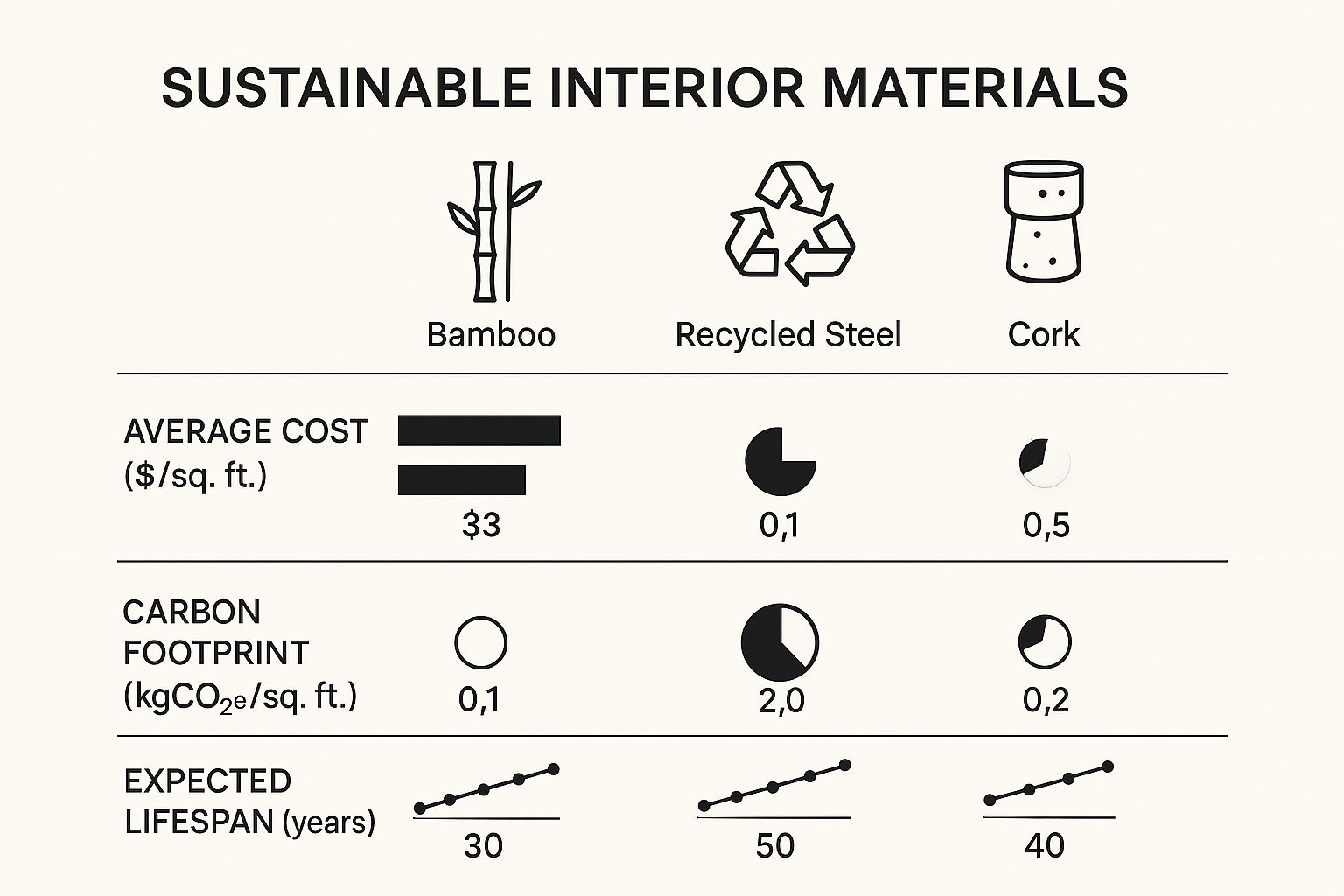
As you can see, materials like bamboo and cork really shine. They offer a lower carbon footprint and fantastic durability for a reasonable cost, making them strong choices for a sustainable home.
A Quick Cheat Sheet for Shopping
How does this help when you’re shopping? It's simple. If you’re browsing online for bamboo curtains from Joey'z Shopping, scan the product details for mentions of these certifications. In a store, the logo will be on the tag or packaging.
To make it even easier, here's a quick-reference table.
Common Eco-Certifications and What They Mean
| Certification Logo | What It Certifies | Look for It On |
|---|---|---|
| FSC (Forest Stewardship Council) | Guarantees wood and paper come from responsibly managed forests. | Wood furniture, flooring, bamboo products, paper decor. |
| GREENGUARD | Certifies products have low chemical emissions (VOCs) for healthier indoor air. | Furniture, paint, insulation, flooring, mattresses. |
| Fair Trade Certified | Ensures ethical production, including fair wages and safe working conditions. | Rugs, curtains, bedding, baskets, and handmade textiles. |
| OEKO-TEX STANDARD 100 | Tests every component of a textile product for harmful substances. | Bedding, towels, upholstery, curtains, and stylish valances. |
Think of these certifications as telling a story. By learning to read these labels, you're not just buying an object; you're supporting a system of responsibility. Becoming fluent in the language of eco-labels empowers you to shop with real confidence.
Bringing Sustainable Materials Into Your Home
Knowing what sustainable materials are out there is one thing, but actually bringing them into your home is where the magic happens. This isn't about a massive, expensive overhaul. Think of it as a series of thoughtful choices that reflect your personal style and values.
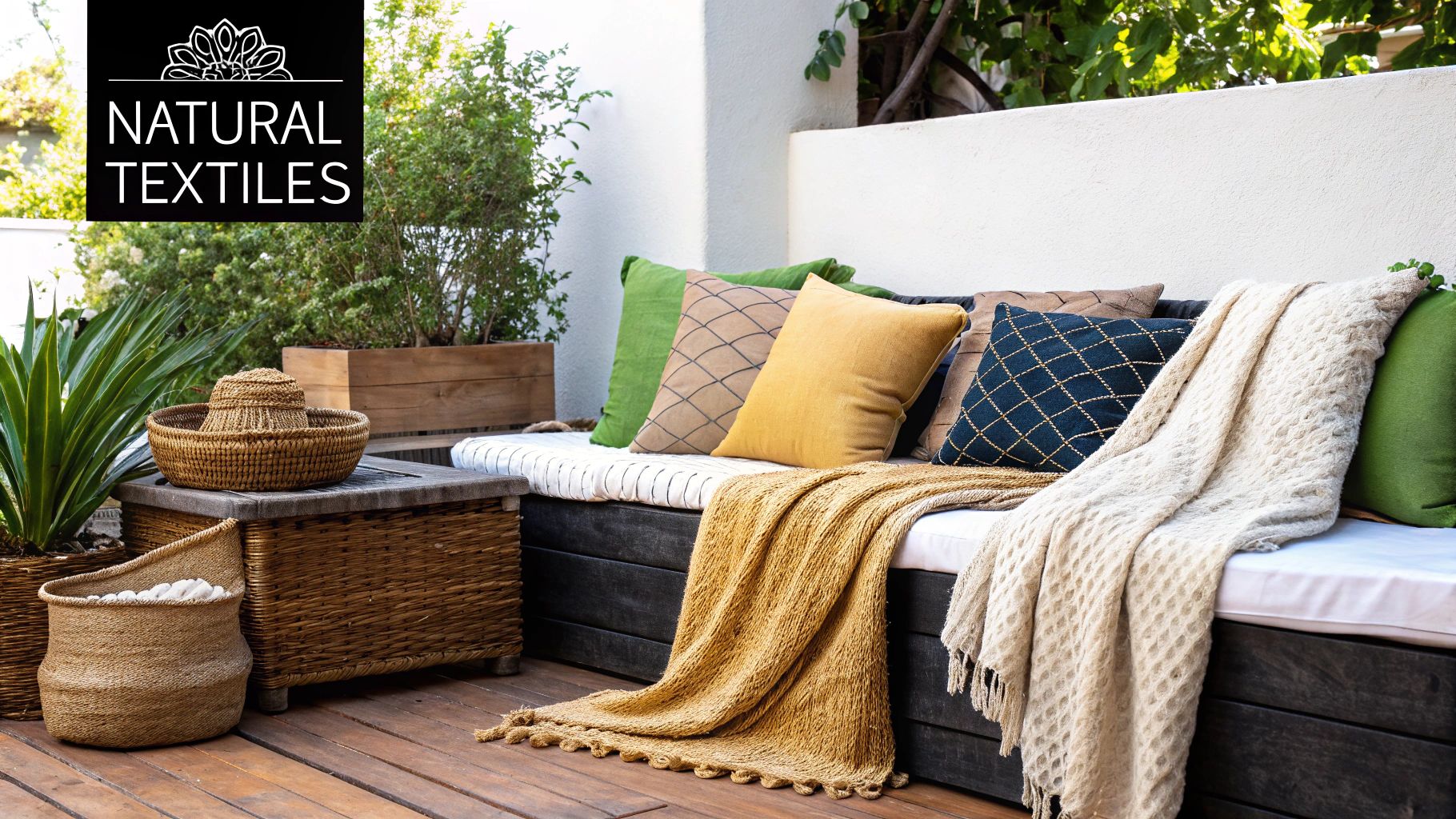
The goal is to weave these elements into your space, room by room, in a way that feels natural and makes a real difference. A few smart choices can completely transform a space, making it healthier and more connected to the world.
Room-By-Room Strategies for a Sustainable Home
Let's walk through how you can sprinkle sustainable interior design materials throughout your home. Every room offers a chance to make a change, whether big or small.
The Living Room: The Social Hub
Since the living room is the heart of the home, it’s a fantastic place to start. A single statement piece can set the tone for the entire house.
- The Anchor Piece: A coffee table made from reclaimed wood creates a natural focal point.
- Textile Swaps: Bring in an organic cotton throw or a handwoven jute rug to add texture and warmth.
- Smart Shelving: Opt for shelving units made from bamboo or FSC-certified wood for a modern look.
The Kitchen: The Functional Core
The kitchen sees a lot of action, so durability and health are top priorities here. This makes it the perfect spot for innovative sustainable materials.
- Flooring Game-Changer: Cork flooring is amazing for kitchens. It’s naturally cushioned and its antimicrobial properties help keep the space clean.
- Cutting-Edge Countertops: Look into countertops made from recycled glass or paper composites. They’re tough and easy to clean.
- Small but Mighty: Start with simple swaps like bamboo cutting boards and utensil holders.
Practical Tips for Getting Started
Jumping into sustainable design can feel intimidating, but a few tips can make the process enjoyable. You don't have to do it all at once; small, consistent steps create lasting change.
The most sustainable home is one filled with items you love, use, and intend to keep for a long time. It's about choosing quality over quantity and intention over impulse.
First, start small with high-impact items. Focus on things you interact with every day. Swapping polyester bedding for breathable organic linen can instantly turn your bedroom into a restful sanctuary.
Second, prioritize rooms where you spend the most time. Your bedroom, living room, and home office are great places to put your energy first. Improving the air quality and comfort in these spaces has the biggest impact.
Finally, embrace secondhand and vintage finds. Thrifting is sustainability in its purest form! Giving a pre-loved piece of furniture a new home prevents waste and adds unique personality to your decor.
Overcoming Common Challenges
Let's talk about cost. It’s true that some sustainable materials have a higher upfront price. But as demand grows, they're becoming more accessible.
Think of it as a long-term investment. A well-made, durable piece from sustainable sources will outlast cheaper alternatives, saving you money down the road. For more ideas on budget-friendly swaps, check out our guide on eco-friendly home decor. This approach helps build a home that's beautiful, healthy, and a true reflection of your values.
Frequently Asked Questions About Sustainable Design
Dipping your toes into the world of sustainable home goods can feel a little overwhelming. To help, we’ve gathered some of the most common questions and answered them in a straightforward, no-fluff way.
Are sustainable materials more expensive?
The short answer is: sometimes, but it’s better to think of it as an investment.
While some sustainable interior design materials might have a higher upfront price due to ethical sourcing, they often save you money long-term. High-quality materials like reclaimed wood are built to last, so you won't be replacing them as often. Plus, budget-friendly options like bamboo and cork are becoming more common.
How do I avoid "greenwashing"?
Greenwashing is when a company makes misleading claims about how eco-friendly their products are. The best way to know if a product is the real deal is to look for credible, third-party certifications.
- Look for the Logos: Keep an eye out for seals like FSC for wood, GREENGUARD for low chemical emissions, and Fair Trade for ethical labor.
- Ask for Transparency: Genuinely sustainable brands are proud of their story and will share details about their sourcing and manufacturing.
Leaning on verified labels helps you make choices backed by real evidence, not just clever marketing.
"True sustainability isn't just a label; it's a transparent story of where a product came from, how it was made, and the impact it has on people and the planet."
What's the easiest way to get started with sustainable materials?
You don’t need to overhaul your entire home. The easiest way to start is with simple swaps that are affordable and impactful.
Textiles are a great place to begin. Try switching to organic cotton towels, upgrading your bedding to linen, or adding a natural jute rug to your living room. Another powerful change is using low- or zero-VOC paint next time you refresh a room to dramatically improve indoor air quality.
Do sustainable materials require special care?
For the most part, no. Sustainable materials are no harder to care for than conventional ones; they sometimes just require different care.
A bamboo cutting board needs the same occasional oiling as any wooden board. Cork floors are sealed and easy to clean with a quick sweep and a damp mop. The best rule is to simply follow the manufacturer's care instructions for any material, sustainable or not.
Ready to bring beautiful, responsible design into your home? At Joey'z Shopping, we believe a stylish home and a healthy planet go hand-in-hand. Explore our curated collection of high-quality, sustainable window treatments and home decor to find the perfect pieces for your space.
